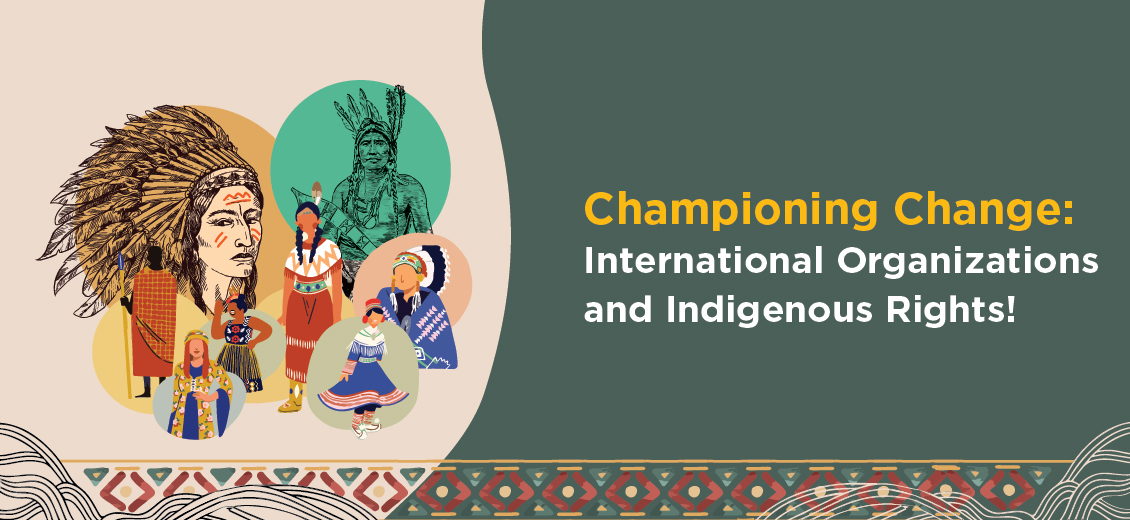Championing Change: International Organizations and Indigenous Rights!
Blogs Home
- 11 Aug 2023

Introduction to Indigenous Rights
Before delving into the various provisions and rights of Indigneous people, the primary step is to understand the purpose and aims of these rights. Indigenous rights are commissioned at both National and International levels by the respective national administration and International Organizations for indigenous communities, officially known as Indigenous people.
Indigenous people are ethnic groups who are native to a particular place and have distinct cultures, languages, and ways of life that are different from the dominant societies. They have a strong connection to their lands and natural resources, which they manage sustainably. They are also inheritors and practitioners of unique traditional knowledge and practices. Some examples of indigenous communities are the Red Indians of America, the First Nations & Metis of Canada, the Sammi community of Sweden, Finland, Norway, and Denmark, and the Kurds of Western Asia.
Despite possessing a vastness of natural resources, and cultural properties, Indigenous people have faced challenges over the decades and centuries like colonization, oppression, discrimination, and exploitation that have threatened their rights, identities, livelihoods, and well-being. They have resisted and advocated for their rights to self-determination, land, culture, development, and participation through forming forums and organizations and with support from their government and other global welfare organizations. They have also contributed to protecting the environment, biodiversity, and human rights through campaigns and movements which have gained strong momentum worldwide.
Thus, Indigenous rights remain an inevitable provision to equip these communities with a legal framework to prevent the ill-treatment meted out to them in various parts of the world. Indigenous rights have been increasingly recognized through the adoption of international instruments such as the United Nations Declaration on the Rights of Indigenous Peoples (UNDRIP) and the Indigenous and Tribal Peoples Convention, 1989, as well as through national laws, policies, and constitutional reforms in some countries.
International Day of the World’s Indigenous People
On 23 December 1994, the United Nations General Assembly decided, in its resolution 49/214, that the International Day of the World’s Indigenous People shall be observed on 9 August every year. The date marks the first meeting, in 1982, of the UN Working Group on Indigenous Populations.
This International Day of Indigenous Peoples 2023, under the title of "Indigenous youth as agents of change for self-determination", revindicates the role that indigenous youth must occupy in decision-making while recognizing their dedicated efforts in climate action, the search for justice for their people, and the creation of an intergenerational connection that keeps their culture, traditions, and contributions alive.
International Organizations and Indigenous Rights
Several international organizations like the International Work Group for Indigenous Affairs (IWGIA), Cultural Survival, Survival International, etc. work to promote, protect and defend Indigenous peoples’ rights. They function as anchor organizations that act as guidelines for other national and private organizations in a well-formulated legal structure. The main objectives of these organizations towards Indigenous peoples and their rights are to develop and adopt international instruments for Indigenous rights and to provide platforms for dialogue and partnership between Indigenous peoples and other people from all walks of life. They also strive to encourage and support Indigenous peoples’ participation and representation in decision-making processes and in documenting and addressing human rights violations.
International organizations like the ILO and IWGIA provide technical assistance, capacity development, and funding for projects that benefit Indigenous peoples as well. The organizations like World Bank are instrumental in allocating funds and preventing the financial injustice and lack of accessibility experienced by Indigenous communities.
International Legal Framework for Indigenous Rights
Speaking of the structured legal framework designated for the rights of Indigenous communities, there are some conventions and declarations that are formulated and adhered to, worldwide. The key conventions are their objectives are summarised here. The UNDRIP, affirms the basic rights of Indigenous peoples in various areas while the Indigenous and Tribal Peoples Convention, of 1989, sets out the rights of Indigenous peoples to consultation, participation, land, culture, and development.
The Convention on the Elimination of All Forms of Racial Discrimination prohibits and eliminates discrimination against Indigenous peoples and the International Covenant on Civil and Political Rights and the International Covenant on Economic, Social and Cultural Rights, recognizes the rights of minorities and encourages self-determination and identity development practices. These conventions have played a central role in assisting the main goal of other organizations like the United Nations, by building safe places for the existence and growth of these communities, even at the grassroots level.
The International organizations follow the UN Declaration on the Rights of Indigenous Peoples and other human rights instruments. They face challenges such as funding, politics, security, and culture, but also have successes such as policy changes, legal cases, documentation, and community empowerment like The Indigenous Community Development National Strategy, The Implementation Science project, and The Cultural Survival’s Community Media Program. These initiatives by the abovementioned organizations have many successful interventions to their credit, like the Federal Sustainable Development strategy.
Challenges Faced by Indigenous Communities
Despite the plethora of organizations and conventions working for the betterment of Indigenous communities, there are many challenges faced by the Indigenous communities that threaten their rights, cultures, livelihoods, well-being, and most importantly, survival and development. Some of these challenges include denial of their right to control their development based on their values, needs, and priorities, lack of, or very poor political representation, limited access to social services, impoverishment and unemployment, violence against women and children, less educational opportunities, inadequate physical and mental health care, issues with voting rights, native languages being threatened, loss of land and resources, human rights violation, discrimination and racism. The adverse climatic conditions of their inhabited regions also factor into the vast array of challenges.
These challenges are the result of centuries of colonialism, historical trauma, and systemic oppression. Indigenous peoples are among the most vulnerable and marginalized groups in the world. They need urgent, informed, and collective action to protect their dignity, identity, andB sustainability.
Indigenous Movements and Advocacy
Some of the major indigenous movements in the direction of advocating, upholding and preventing Indigenous rights are the Global Indigenous Youth Caucus, which advocates for Indigenous youth rights and interests, The Secretary-General’s Youth Advisory Group on Climate Change which advises the UN on climate action and amplifies Indigenous voices, The International Work Group for Indigenous Affair which strongly promotes, protects and defends Indigenous peoples’ rights, Cultural Survival which supports Indigenous radio, culture, and advocacy and The Forest Peoples Programme that supports Indigenous land rights and self-governance policies to eradicate the feeling of ‘outcastness’ in indigenous people.
National Policies and Indigenous Rights
Countries like Australia, Canada, Denmark, Guatemala, New Zealand, Africa, the United States, and some South Asian Nations have developed effective policies to support indigenous rights and build a more inclusive and non-discriminatory environment for these communities to flourish. A total of 113 countries are actively working for the betterment of well-being, education, and employment opportunities across Africa, America, Europe, and Asia.
Their work speaks volumes through these quintessential measures of adopting and implementing international instruments such as the UN Declaration on the Rights of Indigenous Peoples and the Indigenous and Tribal Peoples Convention, by respecting the principle of free, prior, and informed consent of Indigenous peoples for land use and development and infrastructural projects, supporting Indigenous peoples’ role in conservation and climate action, by providing legal recognition and protection of Indigenous lands, territories, and natural resources and by promoting public education and awareness of Indigenous cultures and rights.
Sustainable Development and Indigenous Rights
Sustainable development and Indigenous rights are closely linked, as Indigenous people have always lived in harmony with nature and possess valuable traditional knowledge and practices. Thus, the intersection of sustainability and indigenous communities has always been a peaceful and developing relationship. Recognizing and respecting their rights to land, resources, culture, and self-determination is essential for achieving Sustainable Development Goals and addressing global challenges such as poverty, inequality, and climate change.
Future Prospects
As the global campaign for advocating indigenous rights is actively developing, some challenges remain like lax implementation of existing laws and policies on Indigenous rights and thier continued discrimination and marginalization which can be overcome by collective action towards inclusivity. Some corrective measures for the preservation of cultures and language have been taken by researchers and linguists and social activists to initiate change and create awareness among the masses.
Some other potential future developments include substantially increased awareness and recognition of Indigenous peoples’ contributions to sustainable development, enhanced participation, and empowerment of Indigenous peoples in decision-making processes in the socio-political spheres, and strengthened cooperation and solidarity among Indigenous peoples and their allies. Thus collective action on behalf of communities, nations, and international organizations and individuals is a requisite to advocate for indigenous rights and the flourishment of Indigenous communities.
Sources:
- https://www.un.org/en/observances/indigenous-day
- https://www.amnesty.org/en/what-we-do/indigenous-peoples/
- http://www.firstpeoples.org/the-challenges-we-face.htm
- https://oxfordre.com/internationalstudies/display/10.1093/acrefore/9780190846626.001.0001/acrefore-9780190846626-e-77;jsessionid=9540AC40850E93B5271812F753071773?rskey=Mkc8J8
- https://www.culturalsurvival.org/publications/cultural-survival-quarterly/indigenous-peoples-international-law
- https://social.desa.un.org/issues/indigenous-peoples/united-nations-declaration-on-the-rights-of-indigenous-peoples
- https://harvardlawreview.org/print/vol-129/the-double-life-of-international-law-indigenous-peoples-and-extractive-industries/
- IWGIA - IWGIA - International Work Group for Indigenous Affairs
- Indigenous Community Development National Strategy (sac-isc.gc.ca)
- https://www.worldbank.org/en/topic/indigenouspeoples
- https://www.ohchr.org/Documents/Issues/IPeoples/UNDRIPManualForNHRIs.pdf
- https://unpo.org/article/21755
- https://humanrights.gov.au/our-work/un-declaration-rights-indigenous-peoples-1
- UN Declaration on the Rights of Indigenous Peoples (UNDRIP) (unesco.org)
Tanmaya Kshirsagar

Tanmaya Kshirsagar is an artist, writer and musician. She works with UN Women as a Youth Ambassador and her work has found a place on platforms like Times of India, Indian Review, Women's Web and Medium to name a few.
Blogs Home



